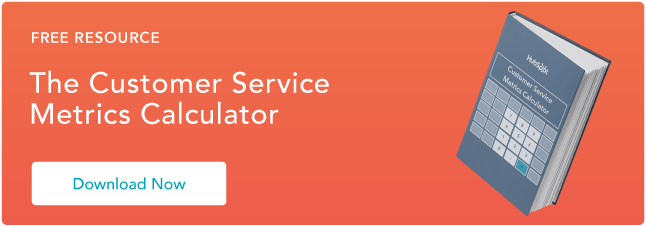1. Determine what success means to you.
First things first, you need to figure out what success means to your business. This will vary depending on your scale, industry, or previous performance in the market.
So, in order to improve something, you need to determine what needs to be improved, and how to improve it. Some examples of questions you should ask yourself include:
- Are customer lifecycles too short?
- Are too many customers churning?
- Is it taking too long for them to purchase again?
Once you’ve identified your problem, you’ll understand what success means to you.
- A customer lifecycle for our business should be X.
- X% fewer customers should churn.
- We should be able to upsell them X times sooner.
And if you were able to achieve this success, what would it mean to your business? Those results could give you $X more revenue annually.
If you know what your areas of focus are, you can more concretely measure the things that matter.
2. Identify the customer retention metrics that can help you inform your goals.
You know what success means to you, but you need to figure out how to get there. Take a step back and look at the factors that affect that definition of success.
Different metrics are used for different goals, and measuring the wrong thing could take the focus off the right things.
For this step, customer retention is good for determining how well customers like your business, while churn rate is more specifically to see the customers lost.
By isolating the factors you need to look for, you’re more likely to calculate precise results than if you used too many variables.
Click here to jump to the full list of metrics.
3. Get the data you need to calculate your metrics.
Upon identifying the metrics necessary, pull from your data the information that’s needed. If you’re using a customer relationship management system to track your customers and their buyer journey, then you should be able to easily extract the numbers from recorded history.
For example, we’ll use the customer retention rate for this section. This formula calls for the number of customers you have at different times.
- Customers at the beginning of the period
- Customers acquired during the period
- Customers at the end of the period
Pull only the data relating to your number of customers from those time periods and input them into the correlating formula.
4. Determine your benchmark.
A benchmark is a standard or point of reference against which things can be measured. It’s important to know your benchmark because it can tell you where you are in comparison to your previous data, and see if you’re improving or falling behind.
For example, we’ll reference back to the customer retention rate example for setting a benchmark.
Customer Retention Rate = (Customers at the End of the Period) - (New Customers Acquired) / Customers at the Start of the Period
If you had 100 customers at the start, 90 customers at the end, and 5 new customers, your retention rate would be 85%. This 85% could be your new benchmark.
Now ask yourself two questions:
- Are we improving based on the original benchmark?
- Is our performance good or bad vs. the rest of the industry?
Use your original benchmark to set realistic goals for the coming period to see how you measure against it.
5. Set a SMART goal.
With your benchmark in mind, it’s time to set your SMART goal. This gives criteria to guide in the setting of objectives in things like project management, employee performance management, and personal development.
The acronym SMART stands for the parameters needed to assign your goal:
- Specific: Make your goal specific or narrow.
- Measurable: Define how you’ll track and prove its progress.
- Attainable: Make your goal realistic for the period.
- Relevant: Align your goal with your values or purpose.
- Time-based: Assign an end date to your goal to prioritize.
Remember, your SMART goal is relative to your business, so don’t overshoot or exaggerate it to compare to your competitors.
So back to that customer retention example, you have a benchmark of 85% retained customers. Based on your business, you may want to make your new SMART goal 90% by the end of the year, measured monthly in the CRM, to create a business your customers love coming back to and advocating for.
6. Monitor the data at an ongoing cadence.
You want to keep up with the metrics you're tracking so that you understand what progress you're making toward your goal. However, it's unreasonable to watch the data every minute of every day.
Determine how often you pull the numbers again. This could correlate with a monthly meeting, quarterly report, or another time frame that works for your business.
You also want your metrics to be accurate, so check for any surprises in the numbers and see what conclusions you can draw upon as time progresses.
7. Adjust as necessary.
Whether you reached your goal or missed the mark, you don’t stop there. Keep adjusting your goals as you scale and grow your business to accommodate any changes your business experiences, and keep customers coming back to — or even advocating for — your business.
Now we know how to measure customer retention, but let’s dial it back and define what customer metrics are in the first place.
What are customer retention metrics?
Customer retention metrics are factors, or variables, used to measure the likelihood of retaining and attracting customers to your business. These units of measurement are used in various formulas created to determine the performance of business operations in a given period.
Why are customer retention metrics important?
The more customers you retain, the more recurring revenue you can generate or the more upsells and cross-sells you can secure later. Plus, a customer who stays with you is happy with your products and services, increasing the likelihood that they’ll refer more customers to you.
Marketing, sales, customer service, and even product management teams can all benefit from customer retention data. This information helps each team fine-tune their contribution to the customer journey and create more delightful experiences for your user base.
While there are plenty of metrics for your business can keep track of, we've curated a list of the most important ones below. Let’s take a look.
Customer Retention Metrics
- Customer Retention Rate
- Customer Churn
- Revenue Churn
- Existing Customer Growth Rate
- Repeat Purchase Ration
- Product Return Rate
- Days Sales Outstanding
- Net Promoter Score (NPS)
- Time Between Purchases
- Loyal Customer Rate
- Customer Lifetime Value

Calculating this data can be time-consuming. And, if you're like me, it can be frustrating trying to crunch numbers only to find the results don't add up. That's why we've created the calculator below to help your team gain accurate insights.
Featured Resource: Customer Retention Metrics Calculator Download for Free
HubSpot's Customer Service Metrics Calculator was built to save you time and calculate your business's customer retention metrics with ease. All you have to do is enter the numbers for your business and instantly see your customer retention rate, revenue churn, customer lifetime value, and more. Track these metrics over time to see how your retention is improving.
Now let’s get down to it.
1. Customer Retention Rate
Measures: the rate a business has retained customers over a period of time.

The most straightforward customer retention formula is, well, the retention rate. You need to understand how much of your customer pool is becoming loyal per period to see if your current strategy is drawing them in at a good enough rate. After all, 65% of the average company’s revenue comes from existing customers.
How to Calculate Customer Retention
It takes time to see how effective your retention strategy is working. To do this, add up the number of customers you had at the beginning of a period, then all the customers that onboarded in between, then the number you had at the end of the period.
Subtract the number at the end from the newly acquired, and divide that solution by the number of customers you had in the beginning.
If you have a relatively small customer list, semi-annual or annual tracking will suffice.
Retention Rate Formula
Customer Retention Rate = (Customers at the End of the Period) - (New Customers Acquired) / Customers at the Start of the Period
2. Customer Churn
Measures: the rate customers stop doing business with you.
 Perhaps the most straightforward of customer retention metrics, your company's customer churn rate refers to the rate at which customers stop doing business with you. Whether the customer has ended or opted out of renewing a subscription, a churned customer is a customer that your business didn’t retain.
Perhaps the most straightforward of customer retention metrics, your company's customer churn rate refers to the rate at which customers stop doing business with you. Whether the customer has ended or opted out of renewing a subscription, a churned customer is a customer that your business didn’t retain.
With that said, attrition in your customer base is natural to a certain degree. For example, a customer may have gone through a major change. Maybe their business was acquired or they went bankrupt. Maybe they no longer need your product or service — but since the average company loses 10-25% of its customers each year, it's important to gauge whether that loss is preventable.
But, if your annual churn rate is greater than 5-7%, it's time to evaluate the happiness of your customers — and find out why there may be a problem. A high churn rate is typically indicative of your product or service failing to meet your customers' expectations or goals.
How to Calculate Customer Churn
How frequently you calculate and examine your company's churn rate will depend on the volume of business your company conducts. For example, if you have hundreds or thousands of customers, it may be prudent for your marketing, sales, or customer success team to track churn monthly.
If you have a relatively small customer list, a semi-annual or annual tracking will suffice. Note that new customers you onboard in whatever time period you choose should not be factored into the churn rate.
Churn Rate Formula
Annual Churn Rate = (Number of Customers at Start of Year - Number of Customers at End of Year) / Number of Customers at Start of Year
Example of Customer Churn
To calculate churn rate, we can use the example metrics below.

Let's say our company started September with 10K customers. At the end of the month, we found that 500 left our business. This would mean our churn rate is five percent ((10,000 customers - 9,500 customers ) / 10,000 customer = 5%).
Now, let's say we gained 275 customers during September and lost 500 more during October. Our churn rate for October would then be 5.11% ((9,775 customers - 9,225 customers) / 9,755 customers = 5.11%).
Retention rate is sometimes confused with churn rate. However, these two metrics are distinctly different.
Churn Rate vs. Retention Rate
Retention rate is the ratio of customers that return to do business at your company. This differs from churn rate because churn rate refers to the number of customers you've lost over a time. A company with a high churn rate would, by default, have a lower retention rate.
2. Revenue Churn Rate
Measures: the rate revenue is lost from existing customers.
Your revenue churn rate is the percentage of revenue you've lost from existing customers in a given period. For example, revenue churn can result from an order cancellation, a plan downgrade, or an end to a business relationship. Particularly for SaaS (Software as a Service) companies, revenue churn rate is a critical indicator of customer satisfaction.
While overall revenue churn rate provides a bird's eye view of customer health, it must be tracked on an individual basis. Your customer success team's primary objective is to proactively ensure customers aren't having problems using your product or service, let alone approaching the point where they downgrade their subscription.
If revenue churn does occur, it's possible that your customer may be on the brink of leaving — and your operations or services team must quickly take action to prevent this from happening.
How to Calculate Revenue Churn Rate
You should calculate revenue churn rate in monthly intervals. Start with subtracting the monthly recurring revenue (MRR) at the end of the month from the MRR you had at the beginning of the month.
Then, subtract any revenue you accrued from upselling or cross-selling to existing customers. Finally, divide this number by the MRR you had at the beginning of the month.
You may, in fact, end up with a negative percentage, which would mean your revenue gains from existing customers outweighed any losses. But remember, revenue from new customers should not be included in this calculation.
Revenue Churn Rate Formula
Monthly Revenue Churn Rate = [(MRR at Start of Month - MRR at End of Month) - MRR in Upgrades during Month] / MRR at Start of Month
Example of Revenue Churn Rate
To demonstrate revenue churn rate, let's use a similar example to the one we used above.

For this example, let's say that our company began September with an MRR of $50K. In that month, we lost $5K to churn and gained $2.5K from upgrades. For this month, our revenue churn rate would be five percent. ([($50,000 - $45,000) - $2,500] / $50,000 = 5%).
For October, since we've gained $2.5K in upgrades as well as $10K in new MRR our starting MRR is going to be $57,500. If we lose $7K to churn and gain $3K to upgrades, our churn rate would be 6.95% ([($57,500 - $50,500) - $3,000] / $57,500 = 6.95%).
3. Existing Customer Revenue Growth Rate
Measures: the rate your business is generating revenue from customer success.

Research shows that most businesses make sales to between 5% and 20% of new customers, but that jumps to 60% to 70% for existing customers.Existing customer revenue growth rate is very important for your business.
A climbing rate would imply that your marketing, sales, and account teams are doing a great job at motivating customers to increase spending. It also means that your customers are quickly realizing the value from your engagement.
Conversely, a floundering or falling growth rate should put your success team on alert.
A stagnant existing customer revenue growth rate could also be dangerous for your business. After all, acquiring a new customer is actually four times more expensive than upselling to a current one, thereby hampering your organization's ability to scale.
If your existing customer accounts aren't growing, you're probably not spending enough time and budget on customer retention and failing to capitalize on easily tapped sources of revenue.
How to Calculate Existing Customer Revenue Growth Rate
Once again, the formula below should only take into consideration revenue generated from existing customers. No new sales are involved in this measurement. Existing customer revenue growth rate can be applied to a single account examined over a long period, or it can be measured to reflect the "big picture."
Customer Revenue Growth Rate Formula
Monthly Revenue Growth Rate = (MRR at the End of Month - MRR at the Start of Month) / MRR at the Start of Month
Example of Existing Customer Revenue Growth Rate
For simplicity's sake, let's use the same example as the one above.

If we start September with an MRR of $50K then lose $5K to churn, our existing revenue growth rate is -10% (($45,000 - $50,000) / $50,000 = -10%). For October, if we start at $57.5K and lose $7K, our existing revenue growth rate is -12.2% (($50,500 - $57,500) / $57,500 = -12.2%).
4. Repeat Purchase Ratio
Measures: the rate customers come back for another purchase.
 In simple terms, the repeat purchase ratio (RPR) is the percentage of customers that have returned to buy from your company again. This metric is a great indicator of customer loyalty — often used by marketing and sales teams to assess the performance and impact of the company’s customer retention strategy. Although this particular metric typically applies to products, you can also apply the same formula to repeat subscription or contract renewals.
In simple terms, the repeat purchase ratio (RPR) is the percentage of customers that have returned to buy from your company again. This metric is a great indicator of customer loyalty — often used by marketing and sales teams to assess the performance and impact of the company’s customer retention strategy. Although this particular metric typically applies to products, you can also apply the same formula to repeat subscription or contract renewals.
What's especially useful about repeat purchase ratios is their application to specific demographics. By taking a look at which types of consumers or companies are making the most repeat purchases, you can adjust your target buyer personas accordingly and inform marketing about where their efforts should be augmented or concentrated.
How to Calculate Repeat Purchase Ratio
This is a measurement that can be calculated in any timeframe — weekly, monthly, quarterly — and your customer success team will still find the data valuable.
In a B2B context, for example, you may sell a widget that's used in the manufacturing process of several different customers who sell several different products. Each customer's demand for your product may vary based on its own sales cycle, manufacturing procedures, etc. One new customer may make one large purchase order from you at the beginning of the year, while another may make purchases every month.
In this sense, the RPR should be taken with a small grain of salt. If your customer success team is really on its A-game, they'll also benchmark purchasing frequency for each individual customer in addition to the overall repeat purchase rate.
Repeat Purchase Ratio Formula
Repeat Purchase Ratio = Number of Returning Customers / Number of Total Customers
Example of Repeat Purchase Ratio
Let's say we start the month with 5K customers subscribing to our product or service. At the end of the month, only 4K of those customers return to our business. In this case, our repeat purchase ratio would be 80% (4,000 customers / 5,000 customers = 80%).
5. Product Return Rate
Measures: the rate products are returned.
 Another metric that applies specifically to companies that sell tangible products (as opposed to services or subscriptions), is your product return rate. This is the proportion of your total units sold that have been sent back to you.
Another metric that applies specifically to companies that sell tangible products (as opposed to services or subscriptions), is your product return rate. This is the proportion of your total units sold that have been sent back to you.
Although products could be returned for myriad reasons, product returns are never good, and the ultimate goal is to keep this number as close to zero as possible.
While the B2C retailer average return rates for in-store and online purchases hover around 9% and 20% respectively, product returns in a B2B setting can be a bit more lethal. Given both the larger sales volume and extended duration of the average B2B sales cycle, product returns can be extremely problematic for your customer retention strategy. Customer service teams must quickly make amends before the sale (and/or customer) is lost entirely.
Product return rate is most certainly a data point that customer success teams must pay close attention to. Not only can customer success managers use it to justify reaching out to internal parties and jumpstarting the damage control process, but they can also use the information to let the right people know where the product or its delivery needs to be improved.
How to Calculate Product Return Rate
The timeframe for your product return rate will also depend on your sales volume. What's effective for another company may not work for yours. But here's the base formula and it's important that whatever period you choose to contextualize the calculation, you consistently adhere to it.
Product Return Rate Formula
Product Return Rate = Number of Units Sold That Were Later Returned / Total Number of Units Sold
Example of Product Return Rate
For this example, let's say we're a sporting goods company selling baseball cleats. In September, our most popular item sold 10K units, but 7K were returned later that month. Our product return rate would be 70%, which may indicate a significant problem with that shoe (7,000 units returned / 10,000 units = 70%).
6. Days Sales Outstanding
Measures: days taken to collect payment from a sale.
 In a nutshell, days sales outstanding (DSO) can be described as the average number of days that receivables (customer dues, bills, payments) remain outstanding before they're collected. DSO not only shows how well your company's accounts receivables are being managed, but also how committed a customer is to maintaining a healthy working relationship with your business.
In a nutshell, days sales outstanding (DSO) can be described as the average number of days that receivables (customer dues, bills, payments) remain outstanding before they're collected. DSO not only shows how well your company's accounts receivables are being managed, but also how committed a customer is to maintaining a healthy working relationship with your business.
The longer the DSO, the longer it's taking customers to pay their bills — which may be a bad omen for your customer retention strategy. It's important to look at DSO as a whole to identify trending behaviors and what you can do to combat DSO figures on the rise.
But on an individual basis, a lengthy DSO could mean your customer is dissatisfied with your company's product or service, or that your marketing and sales teams are nurturing and closing customers with credit or cash flow problems. Remember, effective customer success strategies begin before the acquisition stage.
How to Calculate Days Sales Outstanding
DSO is usually applied to the entire set of invoices that a company has outstanding at any given time, rather than to a single invoice. You can determine your DSO on a monthly, quarterly, or annual basis by dividing the number of accounts receivable during the selected time period by the total value of credit sales during the same period. Then, multiplying the result by the number of days in that timeframe.
The final figure is equated with the average number of days it takes your company to collect on an invoice. But for simplicity's sake, we’ll use an annual DSO formula, which can be found below.
Days Sales Outstanding Formula
Annual Days Sales Outstanding = (Accounts Receivable / Annual Revenue) × 365 Days
Example of Days Sales Outstanding
Let's say our hypothetical company made $100K in sales this year. Of that $100K, $75K has been collected. In this case, our annual DSO would be 274 days (($75,000 / $100,000) x 365 days = 274 days) and our monthly DSO would be 23 days (($75,000 / $100,000) x 31 days = 23 days). That could be low or high depending on the industry you're working in.
7. Net Promoter Score® (NPS)
Measures: customer satisfaction and how likely customers are to refer your business to others.
 Net Promoter Score quantitatively measures general satisfaction and loyalty to your brand. Once you've calculated your overall Net Promoter Score, it will tell you if your customers are content and willing to refer your products or services to others.
Net Promoter Score quantitatively measures general satisfaction and loyalty to your brand. Once you've calculated your overall Net Promoter Score, it will tell you if your customers are content and willing to refer your products or services to others.
What's more, if you compare your Net Promoter Score to your revenue growth rate and customer churn rate, you may be able to predict potential growth through customer retention and referrals.
While a high NPS does not guarantee growth and retention, identifying and incentivizing brand evangelists can help drive referral business. This can work exceptionally well alongside content marketing initiatives such as the creation of case studies, website testimonials, and other forms of social proof.
Conversely, a poor or middling score provides the opportunity to address a satisfaction problem before it's too late.
How to Calculate Net Promoter Score
As simple as it may sound, this score is determined by asking your customer one question: "How likely are you to recommend our company to a friend or colleague?"
That's it! The customer is then prompted to choose a score between 0 and 10. Note that only 9's and 10's are promoters, and any customer giving a rating of 6 or below is considered to be a detractor.
If you feel it would be helpful, you can ask a follow-up question in your NPS survey (something along the lines of "Will you share why?") — but keep in mind that response rates decrease as the number of questions asked increases.
Then, you can calculate Net Promoter Score by subtracting the percentage of detractor responses from the percentage of promoter responses.
Net Promoter Score Formula
Net Promoter Score = % of Promoters - % of Detractors
Example of Net Promoter Score
A smart company would distribute an NPS survey after a customer service case is resolved. If after a month, we observed 50 promoters, 25 neutral scores, and 10 detractors, our overall NPS would be 47 (50/85 = 59%, 10/85= 12%, 59% - 12% = 47).
8. Time Between Purchases
Measures: The average time customers take to buy from you again.
 Time between purchases measures the time it takes for an average customer to buy from you again. This is an important retention metric because it shows you how happy customers are with your product or service and how willing they are to try competitors in your market.
Time between purchases measures the time it takes for an average customer to buy from you again. This is an important retention metric because it shows you how happy customers are with your product or service and how willing they are to try competitors in your market.
When tracking this metric, it's important to compare it to other metrics like customer satisfaction and NPS. For example, if you're noticing a lot of time between purchases, that may indicate that your product or service isn't differentiating itself from others in its industry. Or, it could mean that your product is well-built, and customers don't need to buy it again. Comparing time between purchases with other customer satisfaction metrics is a great way to identify overall strengths and weaknesses in your offer.
How to Calculate Time Between Purchases
To calculate the average time between purchases, you'll need to keep track of the purchase dates for all customers. A CRM can help you do this, as it can set up contact properties that record whenever customers make repeat purchases.
Once you have a recording system, you'll need to add together every customer's average purchase rate. For example, if a customer buys from you today, then buys another product a week from now, their purchase rate would be seven days. If they bought from you again two weeks later, then their average purchase rate would be 10.5 days.
After finding the sum of all individual purchase rates, divide that number by your total
repeat customers. Be sure to exclude any new customers, as this metric should only measure your existing ones who made repeat purchases.
Time Between Purchases Formula
Time Between Purchases = Sum of Individual Purchase Rates / Number of Repeat Customers
Example of Time Between Purchases
For this example, it'll be easier to explain calculations using the Excel sheet below.

In September, our small business only had five repeat customers. By calculating the average purchase rate for each individual customer, we can see how long it took for each one to purchase from us again. Averaging these numbers together leaves us with an average time between purchases being 8 days (40 days / 5 customers = 8 days).
9. Loyal Customer Rate
Measures: the number of customers to repeat purchase over a period.
 Loyal customer rate simply refers to the number of customers who have made a repeat purchase with you within a given time range. Since your most loyal customers buy from you the most, this metric identifies the percentage of your customer base that's demonstrated loyalty to your business.
Loyal customer rate simply refers to the number of customers who have made a repeat purchase with you within a given time range. Since your most loyal customers buy from you the most, this metric identifies the percentage of your customer base that's demonstrated loyalty to your business.
It's important to know how many loyal customers you have because these people are the most valuable members of your customer base. That's because they not only drive the most sales, but they're also the most likely to share positive word-of-mouth about your business. By knowing who these loyal customers are, you can capitalize on opportunities to gather testimonials and encourage customer advocacy.
How to Calculate Loyal Customer Rate
Loyal customer rate is calculated by first identifying the total number of customers that your business had during a given month, quarter, or year. This includes both existing customers and new ones.
Then, you need to find both the number of existing customers who made an additional purchase and the number of new customers who made multiple purchases. Add those values together to get your total number of loyal customers.
Finally, divide your total number of loyal customers by your total customers to get your loyal customer rate.
Loyal Customer Rate Formula
Loyal Customer Rate = Number of Repeat Customers / Total Customers
Example of Loyal Customer Rate
In this example, let's say we had 20K total customers during September. Of that 20K, 2K were existing customers who made additional purchases and 3K were new customers who made multiple purchases. By averaging these values together, we would find that our loyal customer rate comes out as 25% ((2K customers + 3K customers) / 20K customers = 25%).
10. Customer Lifetime Value
Measures: the revenue generated by a single customer.
Depending on the industry you are in, acquiring a new customer can cost five to seven times more than retaining an old one, so your business can benefit from a strategy that prioritizes high-value customers.
Customer lifetime value (CLV) measures how much revenue is generated by a single customer. Whether you sell individual products or services, or you sell software billed annually, this is a metric to track consistently. Ideally, you'd see CLV rise or stay constant, as a shrinking CLV suggests you're either capturing low-value customers or losing customers faster than you had in the past.
How to Calculate Lifetime Value
First, determine the average revenue amount you can expect from a customer over a year. You determine this number by dividing your gross annual sales by the total number of unique customers in that year.
Then, you'll want to determine how long a customer stays with your business in terms of years.
From there, you'll multiply the average revenue per customer by the average lifespan of the customer to produce your customer lifetime value.
Customer Lifetime Value Formula
Customer Lifetime Value = Customer Value * Average Customer Lifespan
where Customer Value = Average Purchase Value * Average Number of Purchases
Example of Customer Lifetime Value
A SaaS company bills customers annually for software. The company took in $5 million in revenue last year and has 2,000 customers. Dividing its revenue of $5 million by its current customer base of 2,000 produces an average revenue of $2,500 per customer per year.
The company analyzed its customer longevity and discovered the average amount of time a customer does business with the software company is three and a half years.
Multiplying the average revenue of $2,500 by the average lifespan of four and a half years yields a customer lifetime value of $11,250.
While these are the top metrics you should be tracking for customer retention, there's more data you can analyze to improve your customer experience. Let's wrap up by exploring those alternatives in the section below.
The Importance of Customer Retention
Your company must allocate time and resources to improving customer retention. If putting together a comprehensive customer retention or success plan currently feels out of reach, then start small. Begin tracking the metrics mentioned here, and your customer base will grow exponentially.
Net Promoter, Net Promoter System, Net Promoter Score, NPS and the NPS-related emoticons are registered trademarks of Bain & Company, Inc., Fred Reichheld and Satmetrix Systems, Inc.
Editor's note: This post was originally published in January 2018 and has been updated for comprehensiveness.

![→ Download Now: Customer Service Metrics Calculator [Free Tool]](https://no-cache.hubspot.com/cta/default/53/e24dc302-9dc2-466f-a5ca-ab4e08633c0f.png)
.png)







![Big Brands That Lost Customers' Satisfaction in 2023 [Where CX Went Wrong + Data]](https://www.hubspot.com/hubfs/companies%20that%20lost%20customers_featured.png)



![How to Calculate Churn Rate in 5 Easy Steps [Definition + Formula]](https://knowledge.hubspot.com/hubfs/ai%20customer%20service%20predictions%20%283%29.webp)